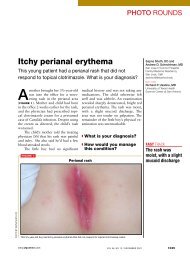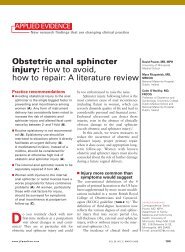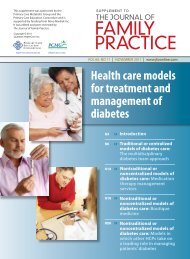Management of morbid obesity - The Journal of Family Practice
Management of morbid obesity - The Journal of Family Practice
Management of morbid obesity - The Journal of Family Practice
You also want an ePaper? Increase the reach of your titles
YUMPU automatically turns print PDFs into web optimized ePapers that Google loves.
have shown similar increases in employment and/or<br />
income after bariatric surgery. It should be noted that<br />
US law prohibits employment discrimination based on<br />
physical attributes that do not affect job performance.<br />
In both <strong>of</strong> the studies cited above, postoperative<br />
quality <strong>of</strong> life tended to decrease somewhat over the long<br />
term. Since HRQOL correlates with the degree <strong>of</strong> weight<br />
loss, this may simply reflect the well-known tendency <strong>of</strong><br />
bariatric surgery patients to regain a modest portion <strong>of</strong><br />
their lost weight after 2 years. In addition, it has been<br />
suggested that patients derive considerable psychological<br />
support from their postoperative visits and may experience<br />
an emotional downturn when those visits cease.<br />
At no time, however, did quality <strong>of</strong> life drop to the<br />
level <strong>of</strong> obese controls. Van Gemert and colleagues<br />
emphasized that this remained true even in patients who<br />
experienced significant surgical complications such as<br />
stoma stenosis or band erosion or disruption. Noting<br />
that other studies have also found surgical complications<br />
to be a nonissue, they commented: “<strong>The</strong> fact that<br />
patients with complications nevertheless experienced a<br />
significant improvement in quality <strong>of</strong> life compared with<br />
the control group highlights the severity <strong>of</strong> the mental<br />
and physical suffering ... before surgery. Apparently,<br />
these patients prefer a nonobese state with surgical complications<br />
over an obese state.” 13<br />
Matching patient and procedure<br />
A <strong>morbid</strong>ly obese patient may be broadly matched to<br />
the most suitable bariatric procedure on the basis <strong>of</strong> several<br />
variables: 14<br />
1) BMI. Some bariatric procedures induce more<br />
weight loss than others. Patients with the highest BMIs<br />
may be guided to procedures that achieve the most<br />
weight loss (eg, biliopancreatic diversion with duodenal<br />
switch, long-limb Roux-en-Y gastric bypass).<br />
2) Age. Older patients (>40 years) may be candidates<br />
for the more definitive procedures (eg, biliopancreatic<br />
diversion, duodenal switch, and long-limb Rouxen-Y<br />
gastric bypass). Despite their complexity, increased<br />
operative risk, and long-term surgically induced <strong>morbid</strong>ity,<br />
such procedures have a lower risk for failure and<br />
need for reoperation.<br />
3) Gender, race, and body habitus. Women may lose<br />
less weight after a given procedure than men. Similarly,<br />
African Americans and possibly Hispanics tend to lose<br />
less weight after a given procedure than Caucasians.<br />
Central (as opposed to peripheral) <strong>obesity</strong> in men and<br />
android (as opposed to gynecoid) <strong>obesity</strong> in women<br />
THE JOURNAL OF<br />
FAMILY<br />
PRACTICE<br />
appear to be associated with more co<strong>morbid</strong>ities that<br />
increase operative risk.<br />
Patients in whom combined gender, race, and body<br />
habitus is ‘unfavorable’ are candidates for a more definitive<br />
operation. If combined status is ‘favorable,’ a simpler<br />
operation (eg, gastric banding) may be appropriate.<br />
4) Co<strong>morbid</strong>ities. <strong>The</strong> patient with few serious preoperative<br />
co<strong>morbid</strong>ities clearly has a better long-term<br />
prognosis than the patient with numerous serious<br />
co<strong>morbid</strong>ities. <strong>The</strong>y can be guided to a simpler, faster<br />
operation, despite the increased risk for subsequent revisional<br />
surgery. When co<strong>morbid</strong>ities predict a poor longterm<br />
prognosis, a more definitive operation with a<br />
lower risk for reoperation is recommended.<br />
Conclusion<br />
Morbidly obese patients who elect to undergo bariatric<br />
surgery experience significant reductions not only <strong>of</strong><br />
weight but also <strong>of</strong> <strong>obesity</strong> co<strong>morbid</strong>ities, including diabetes,<br />
hyperlipidemia, hypertension, and obstructive<br />
sleep apnea, with resultant improved life expectancy.<br />
<strong>The</strong> quality <strong>of</strong> life <strong>of</strong> these patients also has been shown<br />
to improve. While bariatric surgical procedures differ<br />
with regard to degree <strong>of</strong> weight loss, short- and longterm<br />
<strong>morbid</strong>ity, and need for revisional surgery, the data<br />
are difficult to interpret. Thus far, no single bariatric procedure<br />
has emerged as clearly superior to others. ■<br />
REFERENCES<br />
1. Buchwald H, Williams SE. Bariatric surgery worldwide 2003. Obes Surg.<br />
2004;14:1157-1164.<br />
2. McTigue KM, Harris R, Hemphill B, Lux L, Sutton S, Bunton AJ, et al.<br />
Screening and interventions for <strong>obesity</strong> in adults: summary <strong>of</strong> the evidence for<br />
the U.S. Preventive Services Task Force. Ann Intern Med. 2003;139:933-949.<br />
3. Colquitt J, Clegg A, Sidhu M, Royle P. Surgery for <strong>morbid</strong> <strong>obesity</strong> (Cochrane<br />
Review). In: <strong>The</strong> Cochrane Library. Issue 3. Chichester, UK: John Wiley &<br />
Sons, Ltd; 2004.<br />
4. Torgerson JS, Sjöström L. <strong>The</strong> Swedish Obese Subjects (SOS) study—rationale<br />
and results. Int J Obes Relat Metab Disord. 2001;25(suppl 1):S2-S4.<br />
5. Buchwald H. Overview <strong>of</strong> bariatric surgery. J Am Coll Surg. 2002;194:367-<br />
375.<br />
6. Buchwald H, Buchwald JN. Evolution <strong>of</strong> operative procedures for the management<br />
<strong>of</strong> <strong>morbid</strong> <strong>obesity</strong> 1950-2000. Obes Surg. 2002;12:705-717.<br />
7. Pories WJ, Swanson MS, MacDonald KG, Long SB, Morris PG, Brown BM,<br />
et al. Who would have thought it? An operation proves to be the most effective<br />
therapy for adult-onset diabetes mellitus. Ann Surg. 1995;222:339-350.<br />
8. Sjöström CD, Peltonen M, Sjöström L. Blood pressure and pulse pressure during<br />
long-term weight loss in the obese: the Swedish Obese Subjects (SOS)<br />
Intervention Study. Obes Res. 2001;9:188-195.<br />
9. Sjöström CD, Lissner L, Wedel H, Sjöström L. Reduction in incidence <strong>of</strong> diabetes,<br />
hypertension and lipid disturbances after intentional weight loss induced<br />
by bariatric surgery: the SOS Intervention Study. Obes Res. 1999;7:477-484.<br />
10. Buchwald H, Avidor Y, Braunwald E, Jensen MD, Pories W, Fahrbach K,<br />
Schoelles K. Bariatric surgery: a systematic review and meta-analysis. JAMA.<br />
2004;292:1724-1737.<br />
11. Christou NV, Sampalis JS, Liberman M, Look D, Auger S, McLean AP, et al.<br />
Surgery decreases long-term mortality, <strong>morbid</strong>ity, and health care use in <strong>morbid</strong>ly<br />
obese patients. Ann Surg. 2004;240:416-423.<br />
12. Kolotkin RL, Meter K, Williams GR. Quality <strong>of</strong> life and <strong>obesity</strong>. Obes Rev.<br />
2001;2:219-229.<br />
13. van Gemert WG, Adang EM, Greve JW, Soeters PB. Quality <strong>of</strong> life assessment<br />
<strong>of</strong> <strong>morbid</strong>ly obese patients: effect <strong>of</strong> weight-reducing surgery. Am J Clin Nutr.<br />
1998;67:197-201.<br />
14. Buchwald H. A bariatric surgery algorithm. Obes Surg. 2002;12:733-746.<br />
March 2005 Supplement to <strong>The</strong> <strong>Journal</strong> <strong>of</strong> <strong>Family</strong> <strong>Practice</strong> 17









